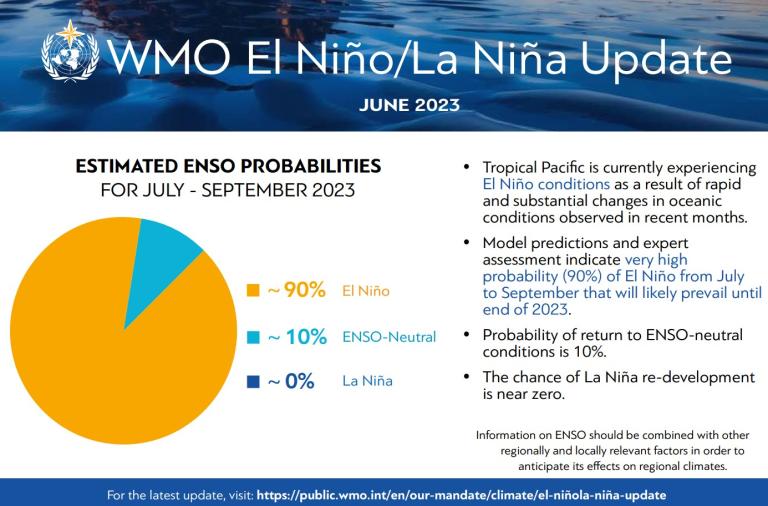World Meteorological Organization declares onset of El Niño conditions

A new Update from the World Meteorological Organization (WMO) forecasts that there is a 90% probability of the El Niño event continuing during the second half of 2023. It is expected to be at least of moderate strength. The WMO Update combines forecasts and expert guidance from around the world.

“The onset of El Niño will greatly increase the likelihood of breaking temperature records and triggering more extreme heat in many parts of the world and in the ocean,” said WMO Secretary-General Prof. Petteri Taalas.
“The declaration of an El Niño by WMO is the signal to governments around the world to mobilize preparations to limit the impacts on our health, our ecosystems and our economies,” he said. “Early warnings and anticipatory action of extreme weather events associated with this major climate phenomenon are vital to save lives and livelihoods.”
El Niño occurs on average every two to seven years, and episodes typically last nine to 12 months. It is a naturally occurring climate pattern associated with warming of the ocean surface temperatures in the central and eastern tropical Pacific Ocean. But it takes place in the context of a climate changed by human activities.
In anticipation of the El Niño event, a WMO report released in May predicted that there is a 98% likelihood that at least one of next five years, and the five-year period as a whole, will be warmest on record, beating the record set in 2016 when there was an exceptionally strong El Niño.
The WMO report in May, led by the UK’s Met Office with partners around the world, also said there is a 66% likelihood that the annual average near-surface global temperature between 2023 and 2027 will temporarily be more than 1.5°C above pre-industrial levels for at least one year.
“This is not to say that in the next five years we would exceed the 1.5°C level specified in the Paris Agreement because that agreement refers to long-term warming over many years. However, it is yet another wake up call, or an early warning, that we are not yet going in the right direction to limit the warming to within the targets set in Paris in 2015 designed to substantially reduce the impacts of climate change” said WMO Director of Climate Services Prof. Chris Hewitt.
According to WMO’s State of the Global Climate reports, 2016 is the warmest year on record because of the “double whammy” of a very powerful El Niño event and human-induced warming from greenhouse gases. The effect on global temperatures usually plays out in the year after its development and so will likely be most apparent in 2024.
The average global temperature in 2022 was about 1.15 °C above the 1850-1900 average because of the cooling triple-dip La Niña.










